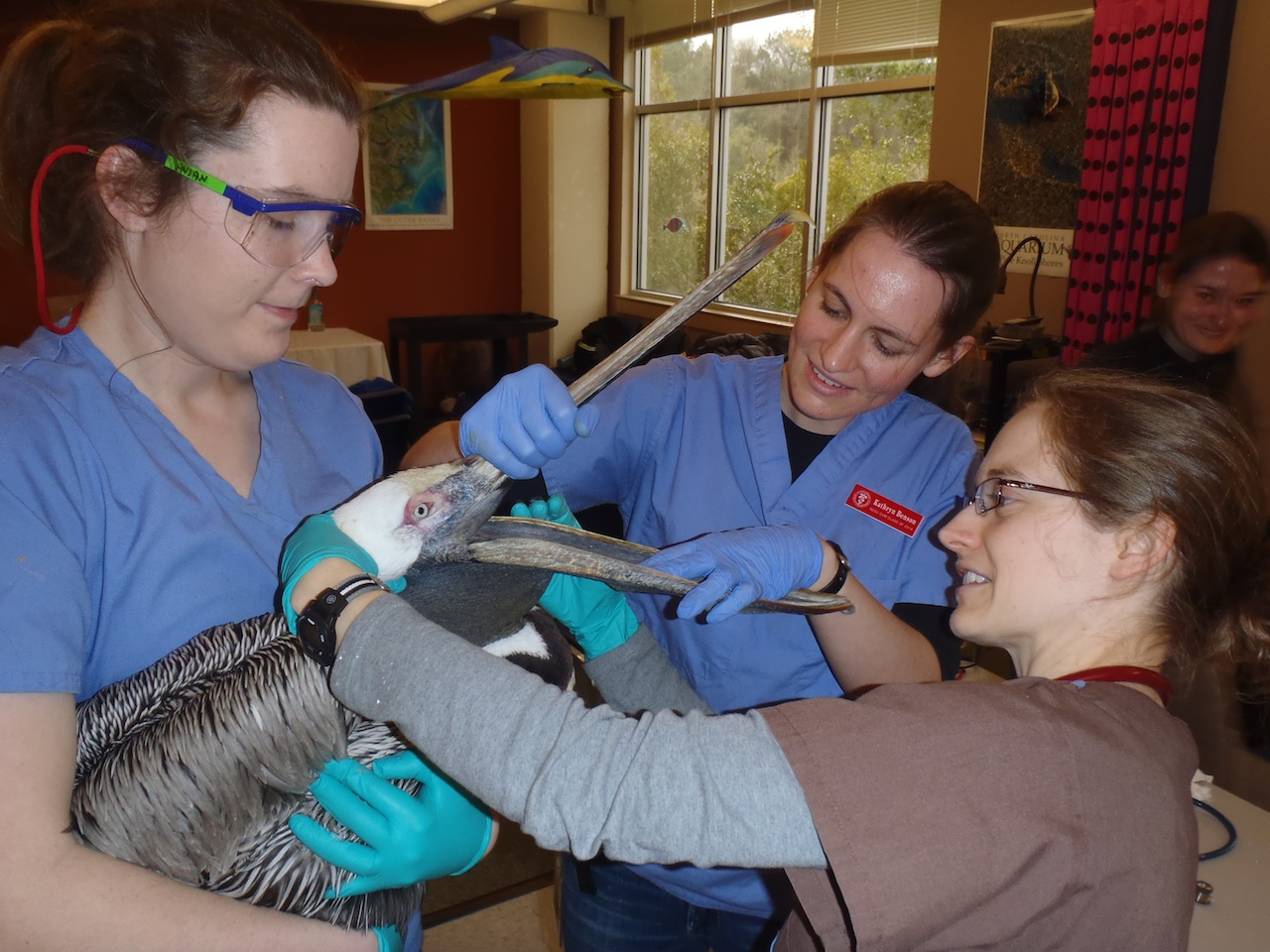NC State Provides Advanced Care for Birds at the North Carolina Aquarium at Pine Knoll Shores

Veterinary students (from left) Carolyn Collier and Kathryn Benson assist Dr. Samantha Swisher in giving a resident pelican an oral exam at the North Carolina Aquarium at Pine Knoll Shores.
[section_subtitle] From information provided by Heather Broadhurst, CMAST research technician [/section_subtitle]
The various birds housed at the North Carolina Aquarium at Pine Knoll Shores (NCAPKS) receive annual physicals from North Carolina State University to evaluate and ensure their health status.
This and other veterinary care for the aquarium is routinely provided by Craig Harms, an associate professor of aquatic, wildlife, and zoologic medicine and a team of zoological medicine residents from NC State’s College of Veterinary Medicine who are based out of the Center for Marine Sciences and Technology. CMAST is a NC State research facility located on Bogue Sound in Morehead City.
There are occasions, however, for capitalizing on the expertise of other veterinarians from the College of Veterinary Medicine’s Veterinary Health Complex in Raleigh and to offer valuable hands-on learning experiences for veterinary students.
One recent example is Laurel Degernes, an associate professor of avian medicine and epidemiology, and five fourth-year students traveled to the coast to visit NCAPKS. The students, who were participating in VMC 996 Advanced Avian Medicine a two-week clinical rotation–came to assist with the examinations of 12 birds.
Dr. Degernes has been bringing avian rotations to the aquarium ever since Pine Knoll Shores started keeping birds in 2009.The current NCAPKS bird collection consists of rescued non-releasable pelicans, owls, vultures, hawks, a kestrel and a laughing gull.
“When the aquarium expanded their collection of fish, reptiles, amphibians and river otters to include birds, it was only logical to call upon the expertise of Dr. Degernes and the Exotic Animal Medicine Service,” says Dr. Harms. “Field service calls at the aquarium allow students to experience a practice setting with patients and clientele that have both differences and similarities to traditional private practice.”
The birds, acquired from wildlife rehabilitation facilities, are non-releasable because of injuries compromising flight capability, neurological deficits, or imprinting on humans. They now serve as part of a summer educational avian program at the Pine Knoll Shores aquarium as well as making occasional appearances in education programs throughout the year.
Each bird is given a full physical examination to evaluate body condition, auscultation of the heart and lungs, feathers, skin, nares, beak, eyes, ears, and throat, as well as the bones and muscles, abdomen, vent, and feet.
Hands-on time with the birds and interaction with the aquarium staff members who are responsible for their daily husbandry, offer a unique learning environment for the veterinary students, and enlisting specialists from the NC State’s CVM enhances the veterinary care for the avian collection at the aquarium.
Read more about the Center for Marine Sciences and Technology.
[section_subtitle] Note: [/section_subtitle]
The NC State College of Veterinary Medicine’s Environmental Medicine Consortium has provided veterinary services through a contract with the NC Aquariums since 2005. The aquariums support one of the three zoological medicine residency positions. The primary field services are headed up by Dr. Harms based out CMAST with additional CVM support from Dr. Greg Lewbart, Dr. Michael Stoskopf, Dr. Suzanne Kennedy-Stoskopf and various veterinary specialty services that might be enlisted for a particular case. The relationship has provided important training opportunities for zoological medicine residents and veterinary students, case material for clinical investigations, and excellent care for the animal collections at three premier coastal public attractions—the North Carolina aquariums at Pine Knoll Shores, Roanoke Island, and Fort Fisher.


